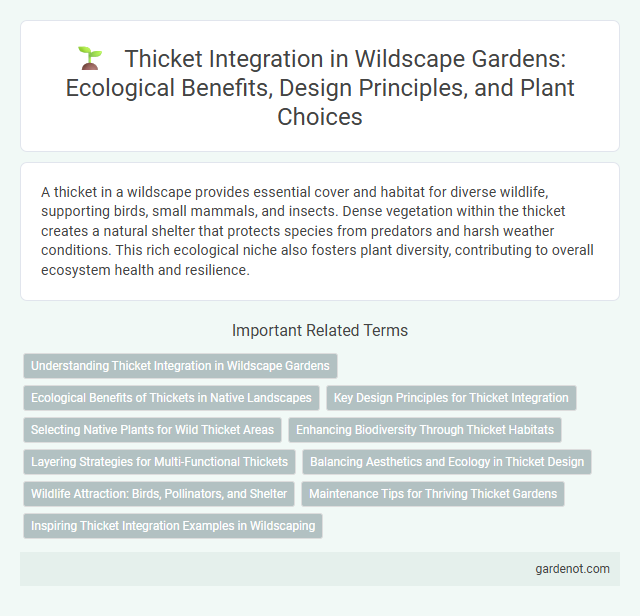A thicket in a wildscape provides essential cover and habitat for diverse wildlife, supporting birds, small mammals, and insects. Dense vegetation within the thicket creates a natural shelter that protects species from predators and harsh weather conditions. This rich ecological niche also fosters plant diversity, contributing to overall ecosystem health and resilience.
Understanding Thicket Integration in Wildscape Gardens
Thicket integration in Wildscape gardens enhances biodiversity by creating dense, layered vegetation that supports a variety of wildlife habitats. This ecosystem design promotes native plant growth and provides shelter and food sources for birds, insects, and small mammals. Effective thicket incorporation improves soil health and water retention, contributing to the overall sustainability of Wildscape environments.
Ecological Benefits of Thickets in Native Landscapes
Thickets provide critical habitat for numerous native species, offering shelter and nesting sites that enhance biodiversity. Their dense vegetation plays a vital role in soil stabilization and erosion control, promoting ecosystem resilience. Thickets also contribute to carbon sequestration and water filtration, supporting overall environmental health in native landscapes.
Key Design Principles for Thicket Integration
Thicket integration in Wildscape emphasizes dense vegetation layering to mimic natural ecosystems, enhancing habitat complexity and biodiversity. Strategic plant species selection promotes ecological balance, supports native wildlife, and ensures sustainable growth patterns. Incorporating adaptive soil management techniques optimizes moisture retention and nutrient cycling for long-term ecosystem resilience.
Selecting Native Plants for Wild Thicket Areas
Selecting native plants for wild thicket areas ensures enhanced biodiversity, soil stability, and natural pest control. Focus on species such as native shrubs, grasses, and understory plants like elderberry, serviceberry, and switchgrass that thrive in local soil and climate conditions. Incorporating plants adapted to the region supports wildlife habitats and promotes ecological balance in wildscape thicket zones.
Enhancing Biodiversity Through Thicket Habitats
Thicket habitats play a crucial role in enhancing biodiversity by providing dense vegetation that offers shelter and nesting sites for a variety of wildlife species, including birds, mammals, and insects. These ecosystems support rich plant diversity, which promotes complex food webs and ecological interactions, fostering resilience and stability within natural landscapes. Maintaining and restoring thickets contributes to habitat connectivity, enabling species movement and genetic exchange vital for ecosystem health.
Layering Strategies for Multi-Functional Thickets
Multi-functional thickets employ layering strategies that combine groundcover, shrub, and small tree species to enhance biodiversity and habitat complexity. Integrating native plants like hazel, blackthorn, and elder in stratified layers supports a diverse range of wildlife, improves soil health, and increases structural resilience. Effective layering optimizes resource use, promotes natural pest control, and strengthens ecosystem services within wildscape environments.
Balancing Aesthetics and Ecology in Thicket Design
Thicket design in Wildscape prioritizes the delicate balance between aesthetics and ecological functionality, fostering habitats that support biodiversity while enhancing visual appeal. Strategic planting of native shrubs and understory vegetation promotes habitat complexity, supporting pollinators and wildlife. Emphasizing natural growth patterns ensures thickets provide essential ecosystem services such as soil stabilization and carbon sequestration.
Wildlife Attraction: Birds, Pollinators, and Shelter
Thickets play a crucial role in wildlife attraction by providing dense cover and abundant resources for birds, pollinators, and shelter-seeking animals. These shrubby habitats offer nesting sites for small birds, nectar sources for bees and butterflies, and protective refuge for mammals and insects. The structural diversity of thickets supports biodiversity, enhancing ecosystem resilience and promoting natural pest control.
Maintenance Tips for Thriving Thicket Gardens
Regular pruning and mulching are essential for a thriving thicket garden, promoting healthy growth and preventing overgrowth. Applying organic compost enriches the soil, enhancing moisture retention and nutrient availability for dense, vibrant vegetation. Monitoring for pests and diseases early ensures timely treatment, maintaining the ecosystem's balance and vitality in the wildscape environment.
Inspiring Thicket Integration Examples in Wildscaping
Thickets serve as vital components in wildscaping, offering dense habitat that supports diverse wildlife including birds, small mammals, and pollinators. Strategic thicket integration enhances ecosystem connectivity by providing natural corridors that facilitate species movement and increase biodiversity. Examples of inspiring thicket use in wildscaping include nesting grounds for songbirds and natural brush piles that shelter beneficial insects, promoting a balanced and thriving ecosystem.
Thicket Infographic

 gardenot.com
gardenot.com